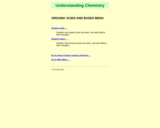
This tutorial presents a review of the definitions for pH and buffer solutions
- Subject:
- Science
- Material Type:
- Lesson
- Provider:
- Chemistry Collective
- Date Added:
- 08/03/2022


This tutorial presents a review of the definitions for pH and buffer solutions

This tutorial describes the effects of adding strong base or strong acid to water.

Chemguide provides information on both organic acids and organic bases.

This StudyCards stack enables students to review the vocabulary that describes chemical bonding.

Basic properties of the element Gadolinium Includes Bohr model.

A site containing a good deal of elemental information. Information on each element includes atomic number, atomic mass, melting point, boiling point, density, isotopes and more.

Use this narrated tutorial to help understand how to balance a chemical equation using coefficients and leaving formula subscripts unchanged. [9:35]

A video tutorial illustrating the basic types of chemical reactions commonly seen in general chemistry. [5:04]

Watch this screencast introducing several common types of chemical reactions. [1:36]

A video lesson which illustrates how to identify and complete a synthesis chemical reaction. [8:08]

This activity is designed to be used a pre-test over types of chemical reactions and balancing.

This lesson summarizes how chemical reactions occur, and that not all reactions go to completion. [1:41]

This video is a professional development resource that explores student misconceptions about atoms, molecules, and chemical reactions. It also gives some pedagogical approaches for approaching these subjects. [10:12]

A college course featuring instructor's notes and case studies about the relationship between exposure to environmental chemicals and human diseases.


Using the mass defect to calculate the energy released when a helium nucleus formed. Introduction to the nuclear strong force. [11:24]
Khan Academy learning modules include a Community space where users can ask questions and seek help from community members. Educators should consult with their Technology administrators to determine the use of Khan Academy learning modules in their classroom. Please review materials from external sites before sharing with students.

In this chemistry and engineering-based activity, students will take on the role of environmental engineers as they are challenged to investigate the best building materials for Mars. To kick off the exploration, they will look at concrete and other key construction materials used on Earth today, considering their properties, pros, cons, and environmental impact. Next, students will investigate the best way to build structures on Mars. They will learn about 3D printing—which is how structures are likely to be built—and they will consider the natural resources available on Mars that could serve as building materials. They will ultimately develop a recommendation to be used in Martian construction moving forward.
Estimated time required: 2-3 class periods.
Technology required for this lesson: Laptop/Desktop, Smartphone.